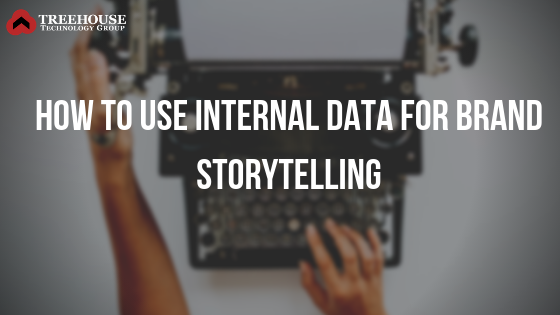Enterprise content marketing platform Skyword recently released the results of a study examining the habits of 1000 content marketers. According to the report only 10 percent of content marketers have embraced branded storytelling, despite its proven effectiveness. The report found that among those top-performing content marketers, 52 percent have embraced storytelling.
Companies struggle to develop a brand storytelling strategy for a variety of reasons. However, oftentimes the best way to execute effective brand content marketing is to use your company’s own internal data. Each of the data sets your company collects and stores offer a wealth of opportunity. This data can be used to tell unique stories about your company, your customers and your product.
Internal data involves all of the information stored on internal databases, in customer profiles and discovered through external research. It can include things like sales trends, customer habits, marketing intelligence, survey results and more.
Data-focused brand storytelling is always compelling because people enjoy learning something new and concrete facts and figures can be educational. However, what makes internal data storytelling so engaging is that it gives the public a look at internal statistics and trends they wouldn’t normally have access to. This data can be used to communicate that your brand is an authority in the industry. Incorporating data into your storytelling is also a form of transparency that can serve to build consumer trust.
Here are three examples of how companies have used their internal data for effective content marketing.
Since 2014, leading search engine company Google has been releasing “Year in Search” videos based on Google Trends data. The “Year in Search” campaign uses data regarding the search engine’s most searched for terms to show what people were most interested in that year. This data is used to provide viewers with a recap of the previous year, often documenting the stories that dominated the news and our lives.
In addition to promoting an emotional response in viewers, with video footage from some of the year’s most heart wrenching tragedies, the campaign also serves to position Google as an expert in the industry and demonstrate its relevance.
And, according to analysis by advertising analytics company Ace Metrix, Google’s 2016 campaign resonated with viewers. The video from that year ranked in the top 1 percent of all ads tested in 2016.
Spotify
Music streaming subscription company Spotify has used data regarding its customers’ listening habits in several marketing campaigns over the years. “To the 1,235 guys who loved the “girls Night” playlist this year, we love you,” read one billboard. “Dear person in the Theater District who listened to the Hamilton Soundtrack 5,376 times this year, can you get us tickets?” read another.
Spotify’s campaign gives the public the sense that everyone is using their music streaming service, leaving those who aren’t already subscribers feeling left out. It’s an effective marketing strategy for promoting the service and gaining new subscribers.
Market research company YouGov highly praised Spotify’s 2016 campaign. The company evaluates brand marketing campaigns according to brand awareness generated and media mentions. According to YouGov, the campaign raised Spotify’s Ad Awareness score by five points and it’s word of mouth exposure score by 16 points.
AirBnB
Hospitality platform AirBnB has long been praised for it’s brand storytelling. The company once teamed up with a canine influencer to promote its pet-friendly listings, and its “We Accept” campaign helped address claims of discrimination at some of the platform’s listings. Like Spotify, the company has also used its internal mdata for brand storytelling.
In 2014, AirBnB launched its One Less Stranger Campaign, an effort that called on AirBnB’s 100,000 users to reduce the number of strangers in the world through random acts of kindness. According to marketing material released the following year, the campaign resulted in 91,000 new guests using AirBnB for the first time and 22,000 new hosts signing up with the platform.
The campaign includes other data shows where users travelled to, which destinations were the most popular, and the remote locations users can visit.
By using its own data, AirBnB’s Happy New Year video accomplished two goals. It demonstrates the geographic diversity users can find when using AirBnB, but it also highlights the success of AirBnB’s own goodwill campaign.
If you want to begin using your internal data to create engaging brand storytelling, contact Treehouse Technology Group today. We specialize in helping companies access their internal data and use it to tell captivating stories.
